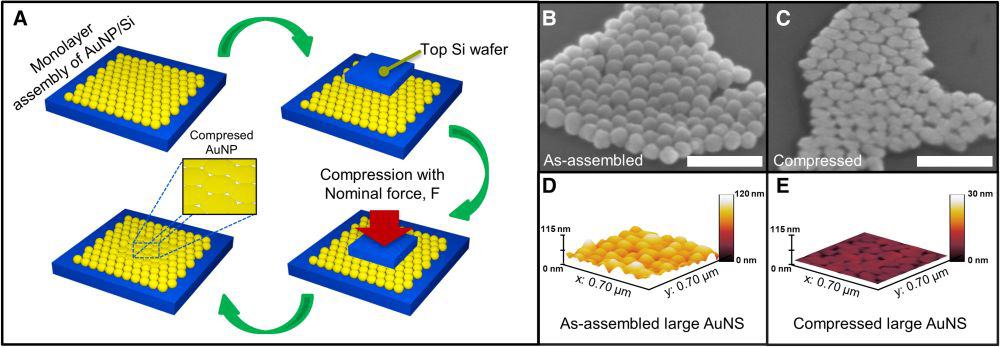
[Image above] a) Schematic showing the compression of a monolayer surface assembly of gold nanoparticles on a silicon substrate. SEM images of as-assembled large gold nanospheres b) before and c) after compression. Scale bars are 500 nm. Atomic force microscopy height maps of d) as-assembled and e) compressed gold nanosphere morphology. Credit: Tanjil et al., PNAS Nexus (CC BY 4.0)
By Laurel Sheppard
Sometimes looking back is the key to moving forward in modern science. For example, you can thank numerous advances in cementitious material design to insights gleaned from analysis of ancient Roman concrete.
In a recent open-access paper, researchers looked to the age-old craft of goldbeating to advance a new frontier for nanomaterial fabrication.
Goldbeating is a technique pioneered by ancient Egyptian artisans more than five millennia ago to turn bulk gold into gossamer-like leaves. In this process, gold ingots (blocks) are pounded into thin leaf form until a desired thickness is reached.
During Egyptian times, the thinness of the gold leaf used to decorate famous tombs, such as ones in the Valley of the Kings and at Saqqara, approached about 300 nm. But today, modern mechanized goldbeating methods allow for golf leaf to be produced with a thickness of only about 100 nm.
To achieve gold thin films of single-digit nanometer thickness, researchers today typically use bottom-up solution-based techniques, such as electrochemical deposition and atomic layer deposition. But because of gold’s malleability, “is it possible to goldbeat down to the few or even single-digit nanometer regime?” the authors of the recent paper ask.
The authors come from the University of South Florida, the University of Illinois at Urbana-Champaign, and Clemson University. They acknowledge that some top-down, solid-state techniques have been explored for fabricating gold thin films. But these approaches mainly entailed lithographic patterning methods, which have resolution, scalability, and crystallinity limitations.
For their mechanical-based strategy, the researchers colloidally synthesized 0D nanospheres and 1D gold nanorods. The term 0D means every dimension of the material (length, width, height) is less than 100 nm, while 1D means one of the dimensions is greater than 100 nm. A hydrophilic polymer called methoxy polyethylene glycol thiol was used as a capping agent to stabilize the colloidal solution and reduce agglomeration.
The colloidal solutions of nanospheres and nanorods were drop-casted and assembled in (sub)monolayers onto polished silicon substrates. They were then subjected to solid-state, uniaxial compression.
The compression successfully transformed the nanospheres and nanorods into 2D gold leaf-like morphologies. The exact morphology depended on the material’s original shape, size, and particle arrangement prior to compression. However, all exhibited significant plastic deformation under about 3.6 GPa applied uniaxial normalized compressive stress.
Classical molecular dynamics simulations were used to provide further insight into the atomistic deformation mechanisms. For example, the researchers determined that during compression, elastic deformation is followed by a plastic deformation regime, in which dislocations form at the contact interfaces and then propagate through multiple possible slip planes within the material.
As-assembled nanospheres with small (18.8 nm), medium (51.6 nm), and large (83.6 nm) diameters experienced vertical out-of-plane z-strains of about 38%, 57%, and 56%, respectively. This strain correlated to reduced thicknesses for the small (11.6 nm), medium (22.1 nm), and large (37.0 nm) nanospheres. Based on these observations, the researchers determined that the smaller nanospheres appear to be relatively less compressible.
Interparticle separation also played a significant role in the final morphology. Materials with larger interparticle separations required almost twice the applied compressive stress to achieve the same thin 2D morphology as materials with smaller interparticle separations.
The researchers note that the interparticle separation value can be changed by, for example, modifying the colloidal concentration and/or solution volume and by attaching capping polymers of different lengths.
Ultimately, the researchers conclude that their nanoscale goldbeating technique revealed itself to be a versatile technique, and they believe it is generalizable to other metallic, polymeric, or ceramic nanoparticles.
“As we share our findings with the scientific community, we eagerly anticipate advancing our understanding of nanoscale metallic deformation and unveiling new science,” says first author Md Rubayat-E Tanjil, doctoral candidate in mechanical engineering at the University of South Florida, in a press release.
The open-access paper, published in PNAS Nexus, is “Nanoscale goldbeating: Solid-state transformation of 0D and 1D gold nanoparticles to anisotropic 2D morphologies” (DOI: 10.1093/pnasnexus/pgad267).
